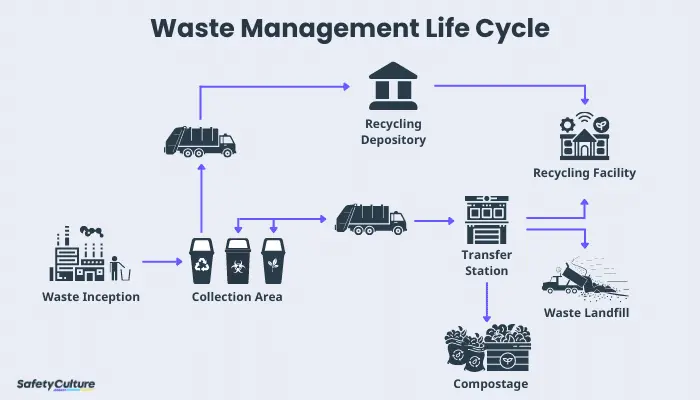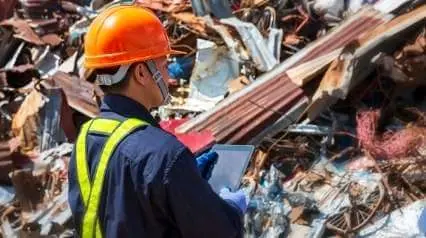What is a Waste Management System?
A waste management system is a streamlined process that organizations use to dispose of, reduce, reuse, and prevent waste. Also known as waste disposal, it is an approach where companies implement comprehensive strategies to efficiently manage wastes from their origin until their final disposal. Possible waste disposal methods are recycling, composting, incineration, landfills, bioremediation, waste to energy, and waste minimization.

As for waste management, it is the measures utilized to manage waste in its entire life cycle, from waste generation to disposal or recovery.
Waste Disposal Methods
There are multiple waste management strategies and methods available. Modern waste management strategies are geared towards sustainability. Other alternatives for waste disposal is to reduce, reuse, and recycle waste.
- Recycling – also known as physical reprocessing, recycling is ideal for the disposal of inorganic waste such as plastic, glass, and metals. Though organic waste such as paper and food can also be recycled, composting would be a better waste disposal method as it converts organic waste into nutrient-rich fertilizer.
- Waste-to-Energy – or WtE on the other hand, is the conversion of non-recyclable waste into heat, electricity, or fuel using renewable energy sources such as anaerobic digestion and plasma gasification.
- Anaerobic digestion – the biological reprocessing of animal manure and human excreta into methane-rich biogas. Plasma gasification uses a plasma-filled vessel operating at high temperatures and low levels of oxygen to transform hazardous waste into syngas. Another option for disposing of hazardous waste is bioremediation, the treatment of contaminants, toxins, and pollutants through micro-organisms.
The 5Rs of Waste Management
The 5Rs of waste management are a set of principles that guide efforts to reduce the environmental impact of waste. These 5Rs are:
- Refuse – This involves saying no to things that are not necessary, such as single-use plastics or excessive packaging.
- Reduce – This emphasizes the importance of minimizing the amount of waste generated by using fewer resources and being more conscious of consumption.
- Reuse – Instead of disposing of items after a single use, consider finding ways to reuse them. This could involve repurposing items or using durable goods that have a longer lifespan.
- Repurpose – This involves giving items a new purpose or use, extending their lifespan, and reducing waste.
- Recycle – Recycling involves processing used materials into new products, reducing the need for raw materials, and lowering the overall environmental impact.
Waste Audit Approaches and Best Practices
Common approaches for conducting waste audits are record examinations, facility walk-throughs, and waste sorting.
- First approach – involves looking at waste hauling and disposal records as well as contracts with recycling facilities.
- Second approach – requires a team of internal auditors to identify waste-generating activities through observation and interviews with employees.
- Third approach – is the physical collection, sorting, and weighing of a sample of the organization’s waste. This sample can be a day’s worth of waste or a collection of waste from each department.
To help with this, businesses can use a digital waste audit checklist before, during, and after a waste audit. It typically contains planning, waste sorting, and descriptions of the organization’s waste stream. Meanwhile, a comprehensive waste management checklist assists in enforcing proper waste protocols in organizations.
Create your own Waste Management Checklist
Build from scratch or choose from our collection of free, ready-to-download, and customizable templates.
Browse Waste Management ChecklistsWaste Management in the Construction Industry
While a waste management system is critical for any industry, there is added pressure on the construction industry to comply with waste management regulations.
For example, the Site Waste Management Plans Regulations 2008 in England requires projects over £300,000 to have a SWMP before starting construction. While SWMPs are focused on construction waste, they can be adapted for use in other industries since, by definition, waste is an example of inefficiency. Though it may be impossible to eliminate the production of waste, using a waste management plan to make small, gradual improvements is a step towards more sustainable operations.
How to Create a Waste Management Plan
Before forming a waste management plan, get input and buy in from various stakeholders. Ask for suggestions on how to be more eco-friendly. Next, assess the strength of the current system by conducting waste audits. After reviewing the waste audit results, identify development needs including budget, estimated waste composition, current waste reduction, and waste generation.
Once goals for the waste management plan have been finalized, perform the following steps:
- Determine the needed resources (containers, vehicles, etc.)
- Assign a point person and clarify their responsibilities
- Prepare a timeline for implementation
Aside from keeping all waste audit results, document the day-to-day waste disposal and resource use of the organization.
Integrate ESG principles into your operations
Drive sustainable growth and create long-term value with our ESG solutions.
Explore nowRole of Training in Implementing a Waste Management System
The best way to engrain these guidelines into your workers is by putting together a robust training program on your waste management systems with the help of a digital operations platform. By reinforcing your waste management system plans through regular training, workers will be better equipped with the knowledge and skills needed to identify potential hazards.
Food Waste Management System
As part of the Target-Measure-Act approach recommended by the World Resources Institute, food waste audits enable restaurants to set reduction targets, measure and report food loss, and be bold in taking action to combat food waste.
How to Conduct a Food Waste Audit in 6 Steps
According to the EPA, there are six steps in conducting food waste audits.
- Develop audit goals and define targeted wastes (for donation, for animal feed, for composting, for recycling).
- Complete a pre-audit questionnaire concerning access to food banks and off-site composters.
- Plan the audit process through determining the waste sorting method, selecting a venue and a date, and obtaining waste sample bins.
- Identify and accomplish audit logistics by coordinating with the staff and giving them the necessary supplies for conducting the audit, such as a digital checklist.
- Collection and sorting of waste.
- Evaluate audit results.
Hospital Waste Management System
Independent auditors perform clinical waste audits to assess a healthcare facility’s compliance with government regulations. In the UK, it is legally required to sort, code, and manage clinical waste, which is defined by the Controlled Waste Regulations as any waste which consists of:
- human or animal tissue, blood or other body fluids, excretions
- drugs or other pharmaceutical products, swabs or dressings, syringes, needles or other sharp instruments
- any other waste arising from medical, nursing, dental, veterinary, pharmaceutical or similar practice
While official clinical waste audits are conducted by independent auditors, healthcare facilities can also choose to prepare for these official audits by conducting their own frequent clinical waste audits.
Hazardous Waste Management System
Hazardous waste management was a key factor in the formation of the Resource Conservation and Recovery Act (RCRA). Hazardous waste is defined by the EPA as waste that is potentially harmful to human health or the environment. However, hazardous waste is only subject to RCRA Subtitle C regulation if it is:
- a solid waste
- not excluded from the definition of solid waste
- not excluded from the definition of hazardous waste
- specifically listed as a known hazardous waste; OR
- meets the characteristics of a hazardous waste; and
- not delisted
Characteristics of a hazardous waste are ignitability, corrosivity, reactivity, and toxicity. As recommended by the EPA, hazardous waste audit checklists are also helpful tools for businesses to use in identifying gaps in their waste management system.
FAQs About Waste Management System
Some of the various waste management types or methods include landfilling, incineration, recycling, composting, waste-to-energy, and source reduction. The method used in disposing of waste would depend on the type of waste to be dealt with.
Implementing a waste management system doesn’t only benefit an organization for legal compliance purposes and in conserving resources—it can also be a cost-saving strategy for a company. Additionally, managing waste properly allows businesses to contribute to the bigger picture of reducing the world’s greenhouse gas emissions.
Landfilling is the most common method used for waste management because landfills can be used to dispose of various types of waste, including municipal solid waste (MSW), construction and demolition debris, and hazardous waste. In recent years, however, new organization strategies are leaning towards more efficient and sustainable ways of disposing of garbage to reduce the amount of waste being sent to landfills.
Although there’s no specific “best” method of waste management per se, sustainable waste management practices such as reusing, recycling, and composting are generally considered ideal since they are more environmentally friendly and efficient.



